Edwin Austin Abbey
Why he was regarded as the "greatest living illustrator" and his advice to a young art student
Edwin Austin Abbey (1852-1911) is one of those Golden-Age illustrators who deserves a big art book and wider recognition.
He was an American expatriate living in England, working in pen and ink, and specializing in historical (especially Shakespearian) subjects. He started painting in oil later in his career, learning a lot from his close friend John Singer Sargent.
Like Ernest Meissonier, Jules Bastien-Lepage and Adolph Menzel, Abbey name was on everyone's lips during his time but is unjustly neglected today. This post will share some fun tidbits and to give you some sources for reading more.
A good place to start are two tributes from Abbey's creative contemporaries, starting with Joseph Pennell, in his book Pen Drawing and Pen Draughtsmanship (1889), called him not only "the greatest English-speaking illustrator, but the greatest living illustrator."
"His present position as an illustrator has been attained and maintained simply by treating illustration, as it should be treated, as seriously as any other branch of art. He is remarkable not so much for academic correctness—as is Menzel, for example—but rather for his truth, the beauty of his line and his power of expression."
"No illustrator has realised more beautiful women or finer swaggering gallants, and no one has placed them in more appropriate surroundings. He makes the figures real for us because all the backgrounds and accessories are taken directly from nature."
Pennell continues: "Menzel is the founder of modern illustration; [Mariano] Fortuny, [Martin] Rico, and [Daniel] Vierge have been its most powerful apostles, and among the cleverest men their influence will never grow less. But while Menzel's methods are obsolete, and Vierge's style can only be attempted by the most brilliant, anyone can see that a new school is arising, and this is the school of Abbey, who has at the present moment followers in every illustrating country in the world."
Abbey's praises were also sung by no less than Henry James:
"There is no paucity about Mr. Abbey as a virtuoso in black-and-white, and if one thing more than another sets the seal upon the quality of his work, it is the rare abundance in which it is produced. It is not a frequent thing to find combinations infinite as well as exquisite. Mr. Abbey has so many ideas, and the gates of composition have been opened so wide to him that we cultivate his company with a mixture of confidence and excitement. . . . None to-day is more charming, and none helps us more to take the large, joyous, observant, various view of the business of art. He has enlarged the idea of illustration, and he plays with it in a hundred spontaneous, ingenious ways."
Abbey’s Advice to a Young Art Student
In 1892, Edwin Austin Abbey received a letter from a young artist traveling through England on his way across to Paris. He wanted advice from the famous illustrator. Here was Abbey's response:
"The great trouble," he wrote, "with the vast majority of our artists at home is that they cease to be students too soon. They spend a couple of years—even three or four years— in Paris, or some other place where students congregate, and, bored by the drudgery of the serious atelier and seeing certain easy-going pictures attracting a certain amount of attention and having also a certain amount of merit, they throw over the opportunity (which, mind you, never comes again) to make themselves as perfect as they may be with the aid of all the facilities a far-seeing body of eminent artists have, during many years, accumulated for their benefit, and dash into paint with a confidence bred entirely of ignorance and intolerance of the training that they, at that ill-informed and blind period of their lives, do not see the need of."
Abbey continued: "Go to the Louvre constantly (on Sunday mornings you will have the place to yourself, or nearly so). Look at the designs and drawings by the great masters and reflect that they thought it necessary to take all that pains before they began their painting, and that they did not rely upon genius or talent to carry them through. Remember that you are pretty blind at present. I don't remember ever before having seen an art student of your age absolutely without a sketch-book. You should be sketching always, always. Draw anything. Draw the dishes on the table while you are waiting for your breakfast. Draw the people in the station while you are waiting for your train. Look at everything. It is all part of your world. You are going to be one of a profession to which everything on this earth means something. Keep every faculty you have been blessed with wide awake. The older you get the more full your life will be getting."
E.V. Lucas, Abbey's biographer, said, "The sketch-books which Abbey himself filled, all of which are preserved, and with which I have spent delightful hours, are proof that he practised what he preached. But probably of no artist of any time can it more truly be said that he was always learning—always preparing to be ready to begin."
Lucas continues: "The tendency of so many young artists to dispense with drudgery was much on Abbey's mind, and there are other references to it in his letters. Among various unfinished fragments of correspondence are the following remarks to the late Charles Eliot Norton. 'In the first place I am convinced that it should be impressed upon this amiable legion, that is to say, the unprepared and usually insufficiently endowed students sent by the charitably disposed to study art abroad, that for a long time the aesthetic part of art instruction should be held in abeyance, that the science of the profession, or calling, should be acquired as patiently and as thoroughly as possible. When I say as possible, I do not mean to place any limit of time or means.
In other words, Art students should focus first on learning the basic skills and science of their craft, and wait until later to explore the artistic or creative side. They should take as much time as they need to learn it well.
Edwin Austin Abbey, May Day Morning. This is his first major oil painting, made when he was 40 years old.
“This science is taught in many continental schools and at the Royal Academy; perhaps in its highest form, aside from these aesthetic questions, at the Ecole des Beaux Arts -and after the hand has learned to obey the eye, then the aesthetic part of the education should begin—years of it, not months. . . . The majority return to their native land full of the latest fad in pictures; and I speak now of America—in the absence, as a rule, of the inspiration derived from American students in Paris the environment of great works of art, they feed for the balance of their days upon a fashion which may have become obsolete on this side of the ocean almost before they have set up their American studios.'"
-----
E. A. Abbey on Wikipedia
Books: Edwin Austin Abbey by E.V. Lucas
Unfaded Pageant: Edwin Austin Abbey's Shakespearean Subjects
Edwin Austin Abbey (1852-1911) Exhibition catalog
Joseph Pennell, Pen Drawing and Pen Draughtsmanship





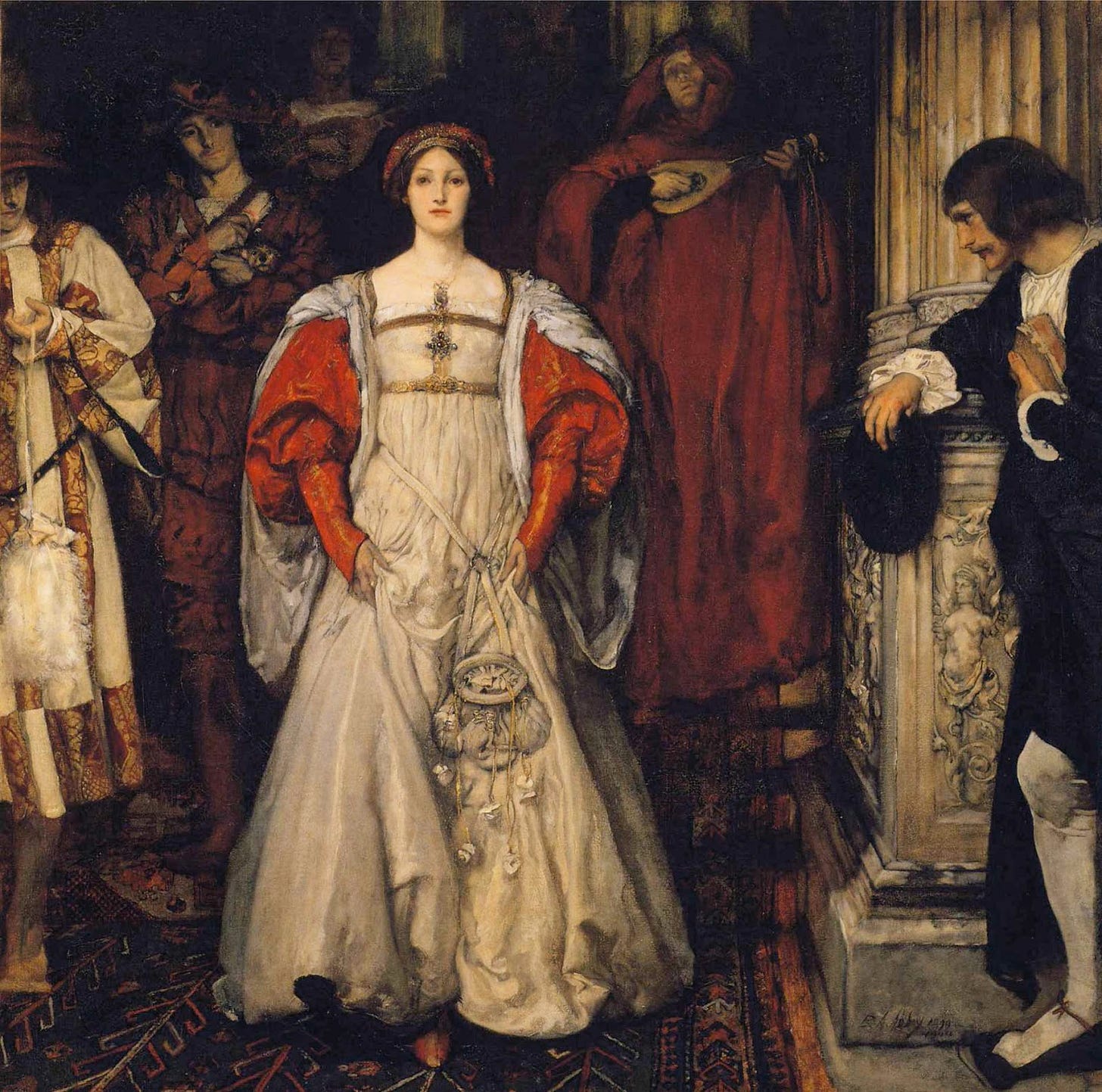
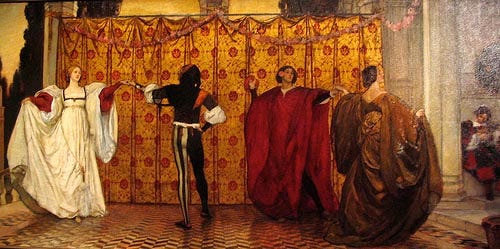

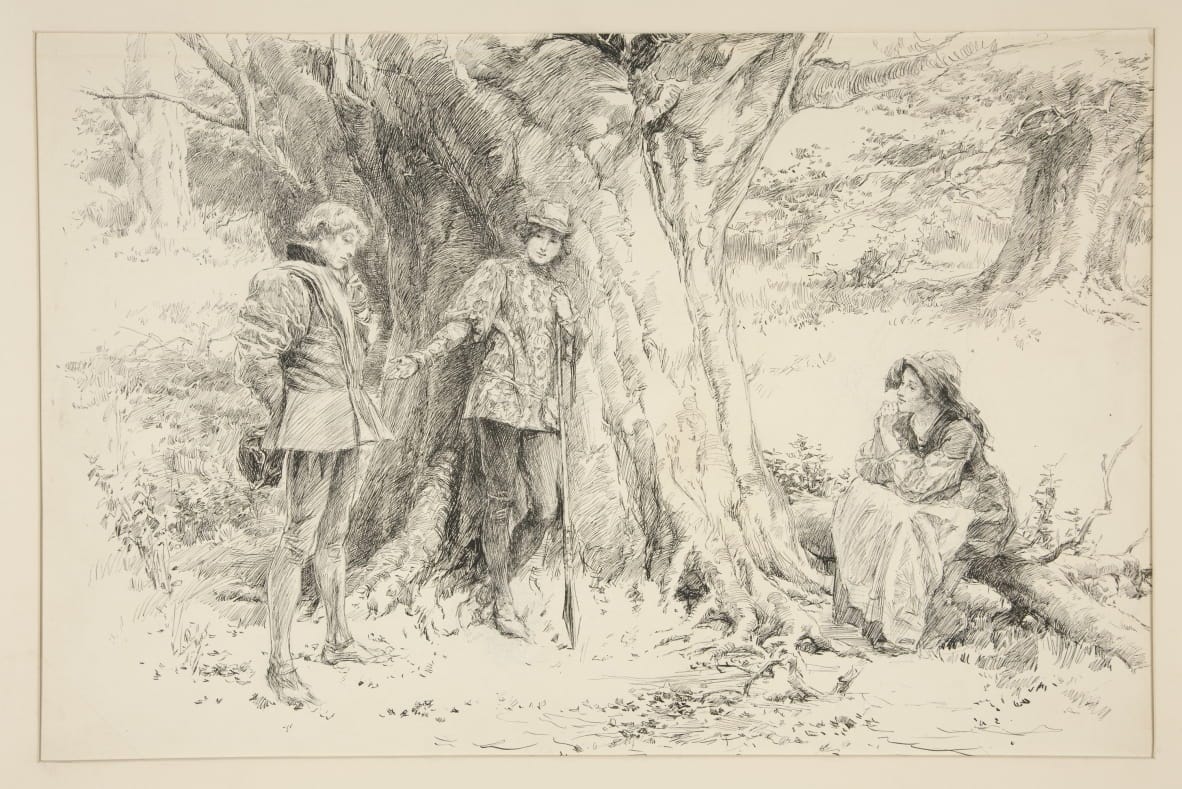
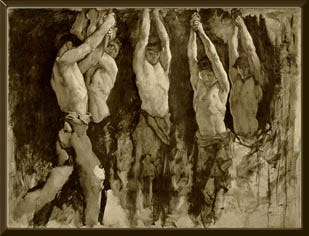
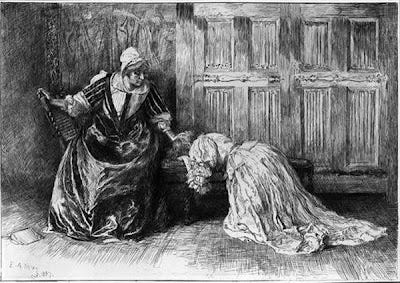
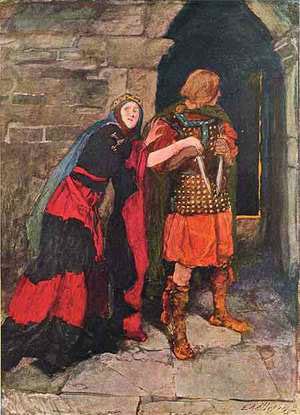

I love the advice to art students! Also, there is a wonderful book, The Drawings of Edwin Austin Abbey, by Alice Carter. She was my professor in grad school, and I had the privilege of hearing her talk about his art career.
His advice about keeping a sketchbook constantly was a huge wake up call! I’d gotten complacent!